project86
Headphoneus Supremus
- Joined
- Feb 21, 2007
- Posts
- 7,804
- Likes
- 4,376
INTRO
This review is something like part 3 in a series. I got this product, the Vivid Technologies V1, and the Monster Turbine Pro Copper Edition all at the same time. I used the 3 extensively, and am just now finishing my 3rd review. So if it seems like I am being unrealistically prolific with my reviews, that is not the case. Some parts will be very similar though as I did a lot of back to back to back listening with different gear using the same tracks.
As I mention in the other 2 reviews, I’m really getting in to computer-as-source music listening. It seems like the audiophile segment is slowly catching on that this area is the future, or at least a big part of it. Computers (and especially laptops and netbooks) are pretty much ubiquitous, hard drive space is dirt cheap, and lossless audio formats are plentiful. The only thing missing is a way to get the music from the computer to some headphones without compromising its quality.
Enter the USB DAC. These little beauties make the quality of your computer pretty much irrelevant, as they do all of the heavy lifting for the audio reproduction. Of course in typical audiophile fashion, I’m sure we will soon have rags like Stereophile espousing the benefits of things like special platforms for PC to sit on (to reduce vibration of course), certain versions of Windows sounding better than others, and ridiculously expensive USB cables (wait, we already have those). I can see it now: a whole cottage industry of tweaks like ERS paper insulation for your PC case, audiophile grade power supplies, high end SATA connectors, and PCI slot covers that block EMI/RFI from getting into your system. If I was less honest, I’d erase those last few sentences and start working on making/selling a few of those as soon as possible.
Thankfully, the computer audio world mostly operates in the realm of sanity, at least for the moment. We have quite a few excellent options for extracting audio through the USB port, which means that even the cheapest netbook can serve as a high end source. Many of these USB DACs also double as a headphone amp, which means you have one less component to carry with you if you are on the go, or one less component to take up desk space if you are listening at home.
The focus of this review is the Audinst HUD-mx1. Audinst is a new company out of South Korea and the mx1 is their first product. I believe the HUD stands for Hi-fi USB DAC. Their website also shows some products “coming soon”: the HUD-mini (presumably a smaller, budget version of the HUD-mx1), the AMP-HP portable headphone amp, and the AMP-mx1 which sounds like a non-headphone related digital power amp. Since the HUD-mx1 is their first product, it should give be a good indicator of what to expect from this company.
The mx1 sells for $179 with free shipping, and can be purchased from their web store on Ebay. The company website is Audinst Inc. Hi-Fi Audio Instrument Solution and they have plenty of information there. Clearly this is a company trying to position itself as a full scale operation rather than a small time Ebay seller.
PACKAGE
The mx1 arrives in what is clearly meant to be a retail box. It has several UPC codes printed on it, and is designed to catch your eye in a store. The box even matches the aesthetics of the mx1 itself, with simulated bolts on each of the 4 corners. A nice touch considering many audio companies treat the package as an afterthought.
Included in the package (aside from the mx1 itself) is a fairly detailed user manual, a basic USB cable roughly 4 feet long, and a set of RCA interconnects that seem extra thick, although they are unlikely to impress your audiophile friends with their basic red and white connectors. You also get the AC adapter along with a 2 prong connector for use in other countries besides the USA, and finally a set of 4 rubber feet to stick to the bottom of the mx1 and keep it from sliding around. It’s a fairly comprehensive package, and I couldn’t ask for anything more at this price range.
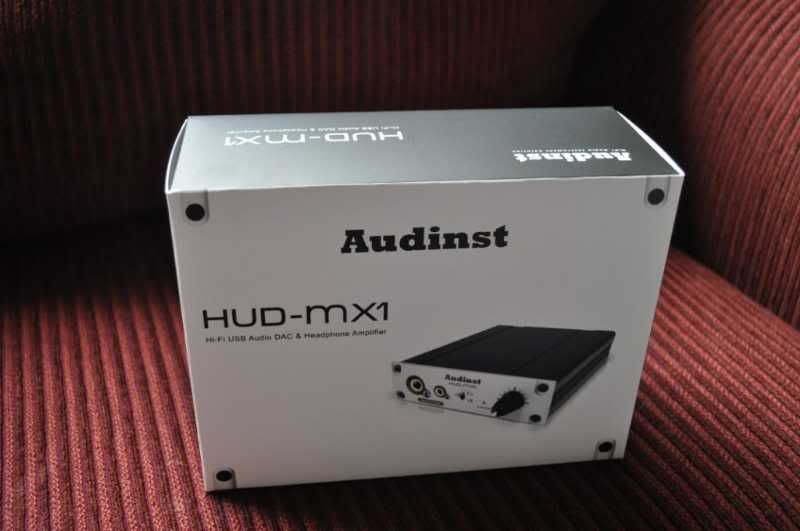
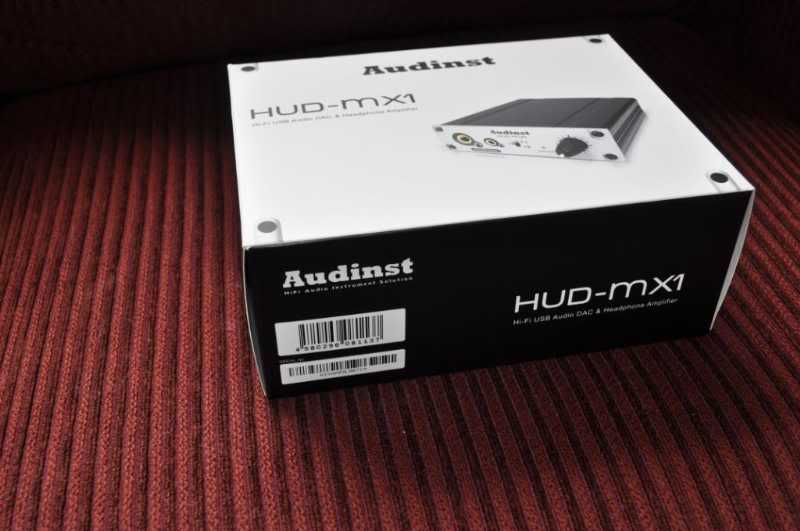
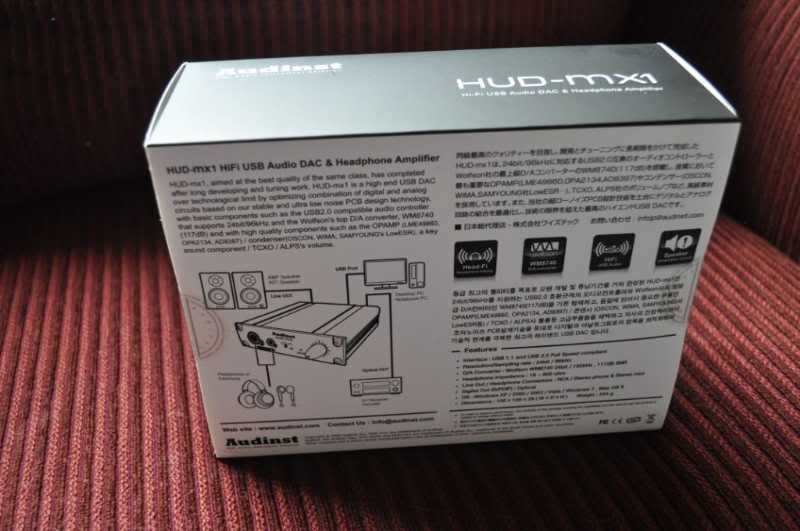
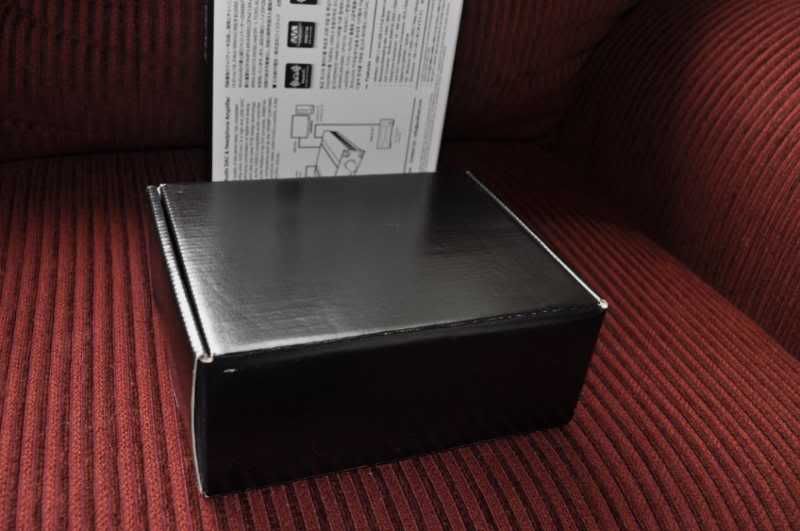
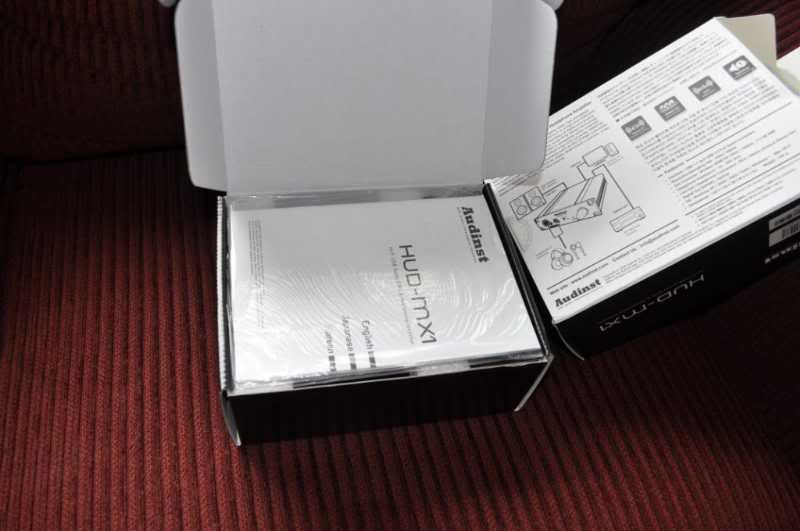

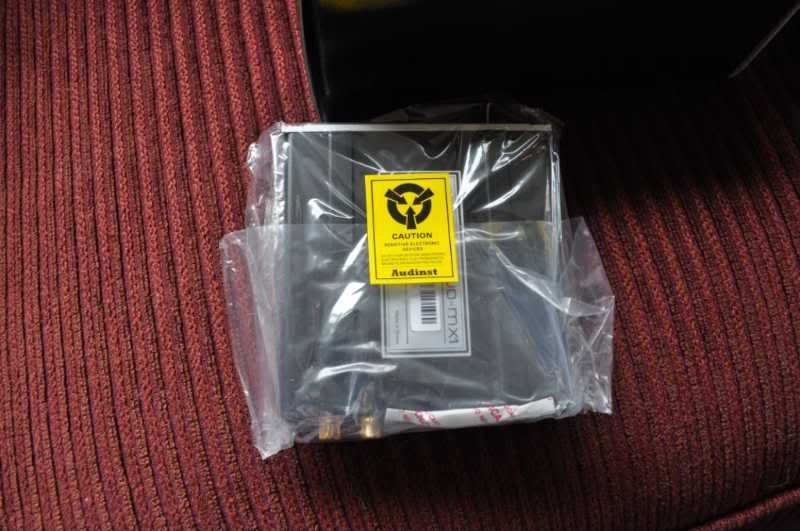

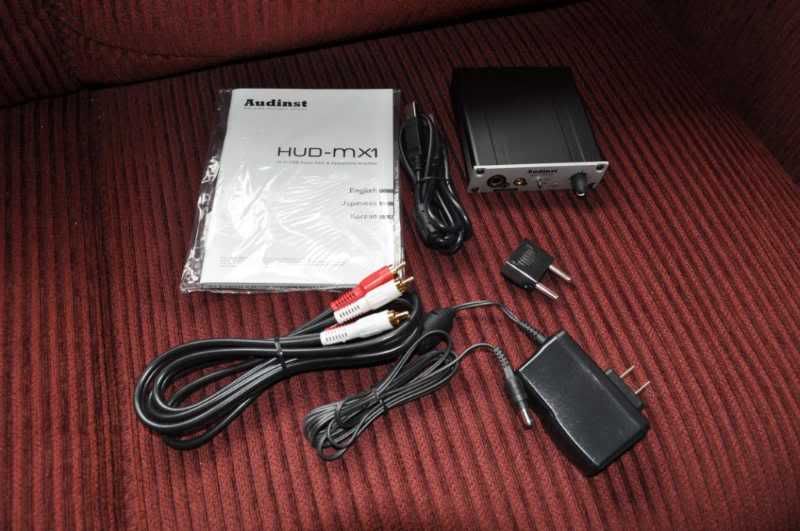
DESIGN
The mx1 is a small unit measuring roughly 4 inches by 4inches by 1 inch. It feels like all aluminum construction except for the rubber volume knob. There is a switch on front for choosing headphone mode or line out mode, and a status light. The light is orange when there is power but no signal, and green when a signal is being received. For different types of headphones, the mx1 features both a 1/8” jack and a 1/4” inch jack. Both remain active at all times so this effectively lets you share the amp for 2 users if you match headphone impedance and sensitivity to within a reasonably close amount. The manual claims that they give you both size jacks so you don’t have to use an adapter which “may cause loss of sound”. OK.
The rear panel of the unit features a USB input of the larger variety, often seen in printers and external hard drives. Next to that is an optical output which enables you to use the mx1 as a USB to SPDIF converter and connect a higher end traditional DAC via optical cable. Move over the other direction and you’ll find a set of standard RCA outputs which have an adjustable output controlled by the volume knob, and finally a plug for the wall wart type power supply. Audinst claims that the USB bus can provide the power in most situations, and that the external PSU is only needed if you plan on using a low power USB hub. I found this to be the case, and never needed to use the external adapter. There is no power switch; the mx1 senses when your computer is off and turns itself off as well, otherwise it stays on when connected to an active USB. There is also an internal jumper for switching to 600ohm mode. The default configuration is supposedly suitable for 32ohm to 300ohm headphones.
Inside the mx1 we find plenty of well known high quality parts. The USB receiver chipset is the Tenor TE7022L which is used in such well regarded products as the April Music Stello U2 and the TeraDak TeraLink X2. The DAC chip used is the popular Wolfson WM8740. The Wolfson DAC feeds into a socketed (user replaceable) National Semiconductor LME49860 opamp, and ends up being output by an Analog Devices AD8397 in the headphone amp section. The analog output features the Burr-Brown OPA2134. Other goodies you’ll see inside are from WIMA, OSCON, Tantalum, and others. The volume is ALPS and there is also a TCXO clock to keep jitter in check. It really is an impressive parts list for somewhat of a low budget device.
Of course none of that really means a thing if not properly implemented. Fortunately in this case we have a well designed unit that is at least equal to if not superior to the sum of its parts. Channel balance even at low volumes is just about perfect, and the volume knob has a nice feel to it. I do hear some minor static from about 3 o’clock to full volume which is around 11 o’clock. I would never listen to anything at this volume, indeed it would likely damage whatever headphones are connected.
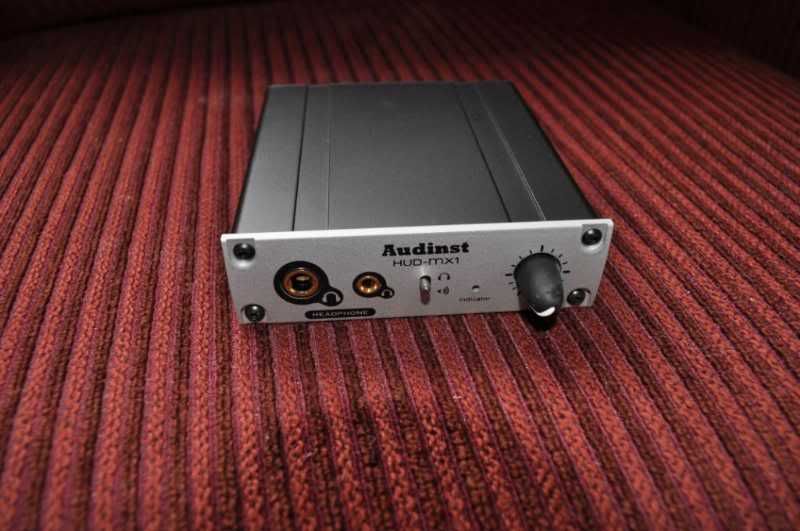

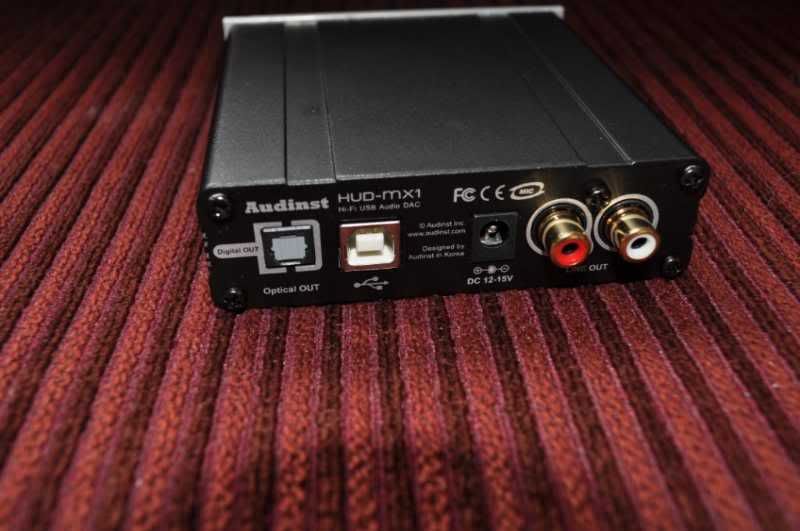
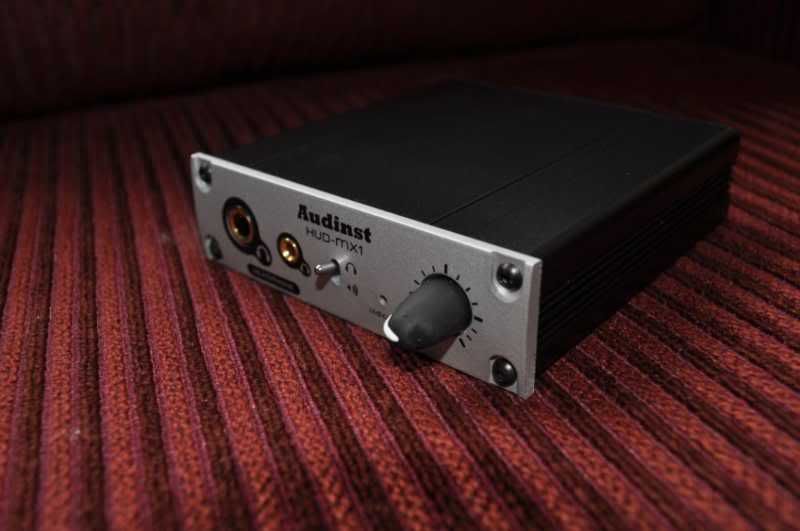
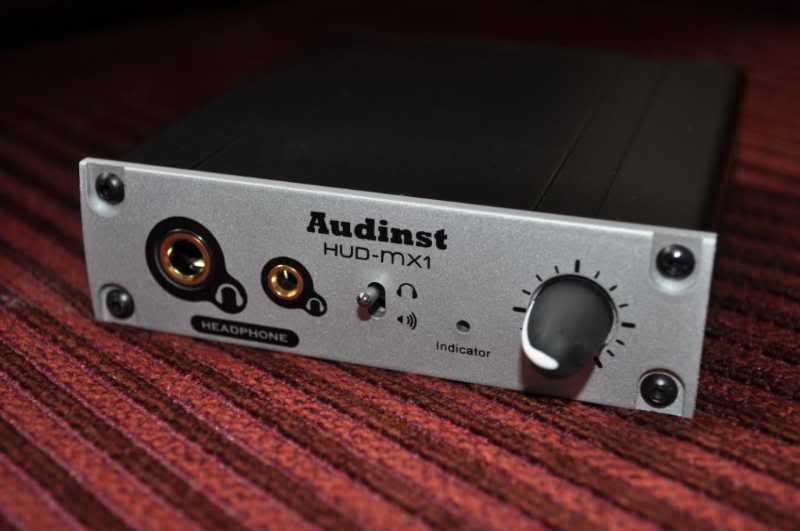
COMPATABILITY
I wasn’t really familiar with the Tenor USB chipset, so I was curious to see easily it worked with different computers, especially compared to the old standby the PCM2704. I’m happy to report that it worked instantly with every computer I could find. My home computers both run Vista 64, and my work PC has good old XP. They all immediately saw the device as “Audinst HUD-mx1”. The nit picky side of me appreciated the actual name showing up rather than just “USB Audio Device” like many other USB DACs.
I decided to be extra thorough so I brought the mx1 and a short USB cable with me on a trip to my local Costco. I went down the line of PCs in the electronics area, and tried about 6 of them. They all had Windows 7 and they all worked perfectly. I don’t have a Mac to test with but Audinst claims in the manual (and even shows screenshots) that it works just as well. Given the results I’ve seen I have no reason to doubt them.
REVIEW GEAR
The mx1 was very helpful while reviewing the Monster Turbine Pro Copper Edition. I also used the LiveWires Trips, AKG K702, AKG K240DF, Sennheiser HD600, and vintage Grado SR325. I compared it to the Vivid Technologies V1 USB DAC/amp and the combination of HRT Music Streamer+ with the Creek OBH-21. I also listened to just the DAC section paired with the Matrix M-Stage amp, and compared the DAC to my Gamma1 and Gamma2. Cables were mostly Impact Acoustics Sonic Wave. To test the pre-amp capabilities, I paired the mx1 with a Teac A-L700P Tripath based amp powering a pair of heavily modified Insignia coaxial monitors featuring Danny Richie crossovers.
I burned the product in for about 100 hours. Not that I believe the sound changed, just simply to check for functionality and to pre-empt any complaints that I didn’t do so. It’s just easier that way.
LISTENING
One of the biggest benefits of computer audio is the ability to play high resolution audio tracks. The availability of 24/96 or higher music has really expanded in the last few years, and it is now possible to find nearly any genre in high resolution instead of just the usual audiophile fare. The mx1 accepts up to 24-bit 96kHz audio, so you are able to play much of the music without any conversion loss. From my informal testing, the step down from 176.4kHz or higher to 96kHz is virtually indistinguishable and the results are very pleasing, much like 1080P video played back on a good 768P plasma display. There might be a noticeable difference if you are really looking, but it is still a big improvement over 480P. Unlike 480P, regular 16-bit/44.1kHz audio can still be amazing, but I still find high res audio to be superior. There’s just a certain “you are there” feeling that it seems to impart, which is difficult to come by on regular CDs and certainly less common. Much like DVD-Audio and SACD, it likely helps that music recorded in a higher resolution is more meticulously recorded and mixed for top notch sound. So it is somewhat difficult to separate the benefits of the newer format versus the improvements gained by simply doing a better job in the studio. But I’m getting off topic.
I used Foober2000 with WASAPI output to achieve bit perfect output with most of my music. The few tracks I have that are higher resolution were converted down to 24/96 using the Foobar Resampler DSP which I felt did a great job. This is the high resolution music I’ve been using for review purposes:
Marianne Thorsen & Trondheim Solistene: Mozart: Violin concerto in D major – Allegro 24/96 FLAC 2L Records
Ola Gjeilo: North Country II – from the album Stone Rose 24/96 FLAC 2L Records
Joel Fan: Gottschalk – from the album West of the Sun 24/176.4 WAV Reference Recordings
Maeve O’boyle: All My Sins – from All My Sins 24/88.2 FLAC Linn Records
Sir Charles Mackerras, Scottish Chamber Orchestra and Artur Pizarro (piano): Piano Concerto No.5 in E flat major, Op.73 ‘Emperor' - Rondo: Allegro, ma non troppo – from 'Beethoven Piano Concertos 3, 4 & 5' 24/96 FLAC Linn Records
Claire Martin: Love Is Real – from A Modern Art 24/88.2 FLAC Linn Records
Nine Inch Nails: 1,000,000 and The Four of Us Are Dying – from The Slip 24/96 WAV Self Release Creative Commons
Livingston Taylor: Isn’t She Lovely – from The World’s Greatest Audiophile Vocal Recordings 24/96 FLAC Chesky Records
Aside from that I tried standard resolution music in FLAC form:
Imogen Heap – Ellipse
Jimmy Eat World – Chase This Light
Big John Patton – Mosaic Select Collection
Albeniz-Fruhbeck De Bergos – Suite Espanola XRCD
All Out War – For Those Who Were Crucified
Shai Hulud – Misanthropy Pure
The Audinst HUD-mx1 immediately impressed me with its transparent presentation. Straight out of the headphone jack with my LiveWires Trips, I knew I was in for a treat, and I ended up not being disappointed. The mx1 seemed to give no real character of its own, but simply allowed the attached headphone to perform at a very high level. It worked equally well with every headphone I tried, and performed nicely in other functions which I will detail later.
LIVEWIRES TRIPS
If you’ve read some of my other reviews, you know these are basically my go-to IEMs. They are incredibly revealing, very efficient, and sensitive almost to a fault. If a source is not up to par, these things will let you know right away.
The mx1/Trips combo is amazingly transparent and neutral. The deep tight lows grabbed my attention right away on some of the classical tracks, which aren’t usually used as demo material for bass. But the mx1 had such articulation and control that I couldn’t help but notice. Highs are excellent too; the mx1 largely avoided the sibilance on the vocals of the Jimmy Eat World album, without sounding at all rolled off or dull.
Micro details are utterly convincing. Livingston Taylor’s stunning rendition of Stevie Wonder’s “Isn’t She Lovely” starts out with him whistling along with guitar accompaniment; we not only hear the slight dampness of his mouth as he whistles, and the pluck of the fingers across the strings, but we soon are able to hear the conga player in the background and tell if they are using a full palm or an open tone with just 4 fingers. We don’t just hear the conga player; we practically see him.
Soundstaging is nice and spacious, with good depth and cohesiveness. It becomes possible to pick out the different layers without feeling mushy or garbled. Many lesser DACs fall short in this area, but the Audinst does a great job.
The LiveWires are great for testing hiss on a headphone amp. As with some of my best amps, the mx1 is just shy of silent at reasonable listening levels. Cranking the volume up past 70 percent or so gives us a relatively quiet but audible hiss. I would never listen this loud in real life.
MONSTER TURBINE PRO COPPER EDITION
These laid back IEMs are one of my favorites. I love their rich smooth sound and their ultrasonic bass that is never too prevalent in the mix. The mx1 seemed able to drive the Coppers to their maximum potential. I was not able to get an improvement even using much higher end amps.
A big strength of the Coppers is how tonally accurate they are when rendering strings. The mx1 excels in this area when paired with the Coppers. On classical music with multiple similar sounding instruments, violins (for example) can be individually distinguished by their unique tonal signatures. Inner details like this are what separate excellent from mediocre.
AKG K702
I like the K702. Many people agree with me, and probably just as many disagree. The Audinst is not likely to change anyone’s mind on the matter.
There is plenty of power on tap here, which is pretty amazing considering the size of the mx1. I once had a pretty large tube amp that will remain nameless, and it was not able to deliver the kind of control and authority with the K702 that this little USB powered box has.
The reason I say that the mx1 won’t win any new fans for the K7XX is the fact that it is very neutral. No added top end sizzle, no boosted bass, none of that extra edginess that lesser amps can create; just even handed linear performance. I don’t find the K7XX to be too analytical at all (a chief complaint among detractors) but feel that they tell the truth in a somewhat exciting way. The mx1 is a perfect match as it seemingly does the same.
AKG K240DF
I love these 600ohm vintage phones, but they can be hard to drive. They have a bit of a thin sound when driven by a mediocre source, and sound downright anorexic with a bad one. The mx1 makes them sound rich and full bodied with plenty of headroom to spare. I think I got to about 2 o’clock on the volume dial and that was only for fairly quiet acoustic folk music. For anything else I topped out even sooner. I never felt the need to switch the internal jumper to 600ohm mode, but I’m glad it is there just in case. Perhaps some difficult Beyerdynamic cans see a benefit from it.
I don’t know how hard it is to acquire these DFs on the used market (they are out of production), but if you can find a pair for a decent price and pair it with the mx1, you’ll have an excellent setup on the cheap. Details are the name of the game with these things, and they are very accurate. The mx1 gives them bass that is just prominent enough without being overbearing. They might not be the last word in extension but they compensate by being excellent in most other areas, and the mx1 puts them on their best behavior.
SENNHEISER HD600
The mx1 has plenty of power to drive these big Senns. Guitars sound round, warm, and very natural. I don’t really get the impression of any “Sennheiser veil” happening here, although that is helped by the fact that these are 600s and not 650s. I hear a lot of subtle nuances and refinement, reminding me that at one time these were a flagship set of cans. The deep bass is well controlled and reminds me a bit of the Monster Coppers in its texture and depth. For me, the K702 gets it slightly “more right” but the differences are very small.
One thing I do notice which could be considered a weakness, and it is likely not the fault of the Audinst but rather a consequence of some deliberate design choice by Sennheiser, is that I prefer male vocals to female vocals with this setup. Even Imogen Heap with her relatively husky voice still suffers from this, and I can’t quite put my finger on what the problem is. It might be that the HD600s are slightly recessed in the upper mid region, and the Audinst does nothing to try and fix that. The Vivid Technologies V1 is more forward than the mx1 and actually fixes this problem for me. But the mx1 has a bit more clarity and impact in the midrange section, so it still comes across well.
GRADO SR325
These are the vintage all black Grado SR325, prior to the gold SR325i and the silver SR325is. Some people love them and some people hate them. I appreciate their somewhat laid back (for a Grado) sound and their deep rich bass which is matched only by the PS1000 as far as I’ve heard.
I really like these SR325 paired with the little Vivid V1. It adds a little bit of top end sizzle and just overall makes them more exciting. The mx1 takes a different route by matching their relaxed (again, for a Grado) delivery and maintaining their unique flavor among the Grado lineup. Of special note is the way that the mx1 widens the soundstage and cleans up the somewhat loose imaging that these things sometimes have. I’ve decided to pick up a pair of flats or HD414 pads to try on these since the mx1 gives enough extra spaciousness to make up for the loss that accompanies flats. It might just make them sound more like the newer SR325 models but I’m going to give it a try.
COMPARISONS
I tried my best to cover all the bases on this feature rich device, but I’m limited with my time and you could spend a month tinkering with all the possible configurations. That’s actually one of the best things about the mx1.
VIVID TECHNOLOGIES V1
I recently posted a review of this little gem; see my sig for the link. It is a great all around performer, somewhat forward but still very enjoyable. It seems to have about the same amount of power as the mx1, which is to say they can both power just about anything properly. The V1 has rugged utilitarian ABS plastic body, which looks a bit plain next to the silver and black aluminum of the Audinst. And while the V1 offers portability, the mx1 offers more versatility in the ability to be used in multiple roles. The mx1 also accepts 24/96 high res signals which the V1 does not. This comes at a price of about $80.
As far as pure sound quality, the V1 is very good but the mx1 is even better. It has more of a neutral balanced sound, a more spacious soundstage, and pinpoint imaging. I can see choosing the V1 for specific applications like the HD600, but the Audinst is great for any headphone you can throw at it.
I tried using the Audinst as a DAC, and then using its analog outs to the line-in on the V1, and I thought it sounded just a tad better than using the V1 alone. This means that either the DAC section on the Audinst is superior, or the line-in on the V1 is inferior. I’m not sure which it is and unfortunately I don’t have time to keep testing various configurations to get to the bottom of it. Realistically the difference is not huge, and when used as stand alone products the Audinst comes out ahead almost every time.
HRT MUSIC STREAMER+ WITH CREEK OBH-21
The HRT Music Streamer+ was my first foray into computer audio. I was impressed with its musicality and low noise, as well as its simple operation. The Creek OBH-21 is an old standby, sort of the gatekeeper of the amp world. If an amp is not better than the Creek, I’m probably not interested.
The Audinst simply outclassed this combo in almost every possible way. More powerful in both volume and drive, more instrument separation, more natural timbre, better soundstage, more realistic attack and decay, the list goes on and on. I found myself at one point thinking the HRT/Creek combo was more “musical”. Eventually I discovered that it was due to the lack of top end sparkle combined with an overall dullness that took me right out of the performance and had me viewing the music from a distance. Imagine standing outside the gate of a loud outdoor concert; you are likely tapping your toes to the music but at the same time completely missing most of the details. I have a theory about NOS DACs that follows this same logic but I need to do some more listening to confirm that.
In contrast, the mx1 was giving me an excellent seat in the front section of the performance. I tried using the mx1 as a DAC and going out to the Creek and it slightly cleaned things up over the HRT but was still pretty uneventful.
MATRIX M-STAGE WITH GAMMA1 OR GAMMA2 DAC
I love the M-Stage. See my review for further details. It is essentially a much higher end amp pretending to be a fairly budget piece of gear. It is also very convenient for comparison purposes since it has 2 sets of inputs which are switchable from the front panel.
First off I tried my AMB Gamma DACs with the M-Stage and compared them to the mx1. Obviously the Gammas don’t have a USB input so I had to use the mx1 to convert USB to SPDIF, then from there proceed as normal to the Gamma and finally to the M-Stage. This was an interesting comparison. The Gamma1/M-Stage combo seemed more dynamic and controlled than the mx1. I noticed this especially with my LiveWires and my K702. On Imogen Heap’s Ellipse, I felt that the combo really showcased the dynamics of her voice, which has a pretty nice range. I noticed it in other areas too like large scale orchestral work and even solo piano stuff. The mx1 presented things a bit more scaled back, but also seemed to have more clarity. I was noticing more tongue and lip sounds besides just the singing, and piano attack was more lifelike. Maybe we could say the combo has better macro-dynamics while the Audinst has better micro-detail.
Next I tried the Audinst as DAC with the M-Stage as amp. This was the best yet, and I can safely conclude that the mx1 is a better DAC than the Gamma1, and the M-Stage is clearly a better amp than the mx1. This explains what I was hearing before; the mx1 DAC providing better resolution but the M-Stage driving the signal better. When you combine the 2 of them, you have a combo that is very hard to beat. The power is there, the control, the resolution, the micro-dynamics as well as the tiny details being presented very clearly. There is a great tonal density and very accurate timbre, and it just feels like you are listening to performers in the room with you rather than a recording. This was especially evident when playing the high resolution tracks with the better headphones, LiveWires and K702 being my favorites of this bunch. Even an album like “The Slip” by Nine Inch Nails, which doesn’t initially come across as being audiophile fodder, sounds startlingly real on some tracks. There is a point on one track in which Trent Reznor’s voice seems to come at you from the extreme side of your room. It is possibly one of the best examples of “outside the speaker (or headphone in this case)” realness I have ever heard, and it is coming from a lowly $430 setup. Of course the great recording in high resolution deserves most of the credit, but still.
When I switched to the Gamma2 DAC with the M-Stage, things were harder to judge. I think I heard some minor improvements with the Gamma2 but it was not easy to pinpoint exactly what was better. Perhaps slightly more ease during very congested passages, and a more intimate feeling of piano mallets striking. I know, that’s all very fuzzy and hard to put into words, but that’s the best I can do. I think the Gamma2 to be slightly superior to the Audinst, but not by a huge margin. That’s a big accomplishment as the Gamma2 is an amazing DAC.
PRE-AMP
I set up a small rig based around a Tripath amp and some decent speakers, and the mx1 did an admirable job. The volume controls the output of the analog outs when used in line-out mode (you have to flip the front panel switch). Obviously you are limited to just the USB input as a source so this is not for use in a larger setup but is perfectly fine for your computer rig.
My Insignia NS-B2111 is a great buy in stock form. It looks like it could be a high end esoteric type mini monitor, and sounds pretty decent too. But when you apply a few simple mods (and 1 or 2 not so simple mods) and upgrade the crossover to a Danny Richie designed version, you end up with a speaker that performs well above its price range, even after the cost of mods. I powered them with the wonderful Teac A-L700P which is a 3 channel digital amp based around the ever popular Tripath chip. This is a pure amp only with no controls, so it’s great that the Audinst allows volume control.
This combo is not the best at bass extension, and still has a bit of raggedness in the 3-7kHz response compared to higher end options. Where it does excel is timing and soundstage. Perhaps due to the coaxial driver setup, these little guys deliver shockingly realistic rendering of stage width and enormous depth focus for their price. The Audinst/Teac/high res music combo made them sound the best I have ever heard them. I confess however to not having ever paired them with anything better than a mid fi receiver, so I guess my comparison isn’t very good. Suffice to say that the Audinst is capable of performing well as a pre-amp.
CONCLUSION
One aspect of the Audinst that I have not completely touched upon is the versatility. What we have here is an excellent DAC paired with a pretty good headphone amp. You could start with the mx1 by itself, eventually upgrade to a nicer stand alone headphone amp, and then eventually even upgrade to a high end DAC while still seeing use from the mx1 as a USB to SPDIF converter. This product can last in your system throughout several upgrades and I think that makes it very useful.
Yet another cool thing is the fact that it will pass through Dolby Digital and DTS signals from the optical output. I connected my laptop to my living room setup and played a few movies on DVD, and this function performed as promised. I got the surround signal on my AVR without any fussing around. I don’t currently have a Blu-Ray drive in my laptop so I was unable to test the performance with Dolby TrueHD or DTS-HD Master Audio. But as far as I understand it, all Blu-Ray discs have some form of backwards compatibility; the lossless DTS track has an imbedded “core” track that should act like standard DTS, and discs with TrueHD tracks are required to have a standard Dolby Digital track as well. I’ve verified this as an early adopter of the format with my early generation Samsung player, and it seems to work well. After all this rambling, what I’m pointing out is that the Audinst HUD-mx1 would serve very well in a home theater PC setup. I used to have an HTPC and back in the day it was not this easy to extract good sound from the box.
If we set aside the extreme versatility of the mx1 and judge it strictly by its sound, it still comes out as a big winner. I don’t want to pretend that it is a giant killer, as I do have some better DACs and some better headphone amps too. But if I had to guess a price for this thing I would have thought perhaps $400 or maybe even more. The fact that it provides you with excellent transparent sound which is suitable for any headphone makes it very appealing, and the versatility is icing on the cake.
This review is something like part 3 in a series. I got this product, the Vivid Technologies V1, and the Monster Turbine Pro Copper Edition all at the same time. I used the 3 extensively, and am just now finishing my 3rd review. So if it seems like I am being unrealistically prolific with my reviews, that is not the case. Some parts will be very similar though as I did a lot of back to back to back listening with different gear using the same tracks.
As I mention in the other 2 reviews, I’m really getting in to computer-as-source music listening. It seems like the audiophile segment is slowly catching on that this area is the future, or at least a big part of it. Computers (and especially laptops and netbooks) are pretty much ubiquitous, hard drive space is dirt cheap, and lossless audio formats are plentiful. The only thing missing is a way to get the music from the computer to some headphones without compromising its quality.
Enter the USB DAC. These little beauties make the quality of your computer pretty much irrelevant, as they do all of the heavy lifting for the audio reproduction. Of course in typical audiophile fashion, I’m sure we will soon have rags like Stereophile espousing the benefits of things like special platforms for PC to sit on (to reduce vibration of course), certain versions of Windows sounding better than others, and ridiculously expensive USB cables (wait, we already have those). I can see it now: a whole cottage industry of tweaks like ERS paper insulation for your PC case, audiophile grade power supplies, high end SATA connectors, and PCI slot covers that block EMI/RFI from getting into your system. If I was less honest, I’d erase those last few sentences and start working on making/selling a few of those as soon as possible.
Thankfully, the computer audio world mostly operates in the realm of sanity, at least for the moment. We have quite a few excellent options for extracting audio through the USB port, which means that even the cheapest netbook can serve as a high end source. Many of these USB DACs also double as a headphone amp, which means you have one less component to carry with you if you are on the go, or one less component to take up desk space if you are listening at home.
The focus of this review is the Audinst HUD-mx1. Audinst is a new company out of South Korea and the mx1 is their first product. I believe the HUD stands for Hi-fi USB DAC. Their website also shows some products “coming soon”: the HUD-mini (presumably a smaller, budget version of the HUD-mx1), the AMP-HP portable headphone amp, and the AMP-mx1 which sounds like a non-headphone related digital power amp. Since the HUD-mx1 is their first product, it should give be a good indicator of what to expect from this company.
The mx1 sells for $179 with free shipping, and can be purchased from their web store on Ebay. The company website is Audinst Inc. Hi-Fi Audio Instrument Solution and they have plenty of information there. Clearly this is a company trying to position itself as a full scale operation rather than a small time Ebay seller.
PACKAGE
The mx1 arrives in what is clearly meant to be a retail box. It has several UPC codes printed on it, and is designed to catch your eye in a store. The box even matches the aesthetics of the mx1 itself, with simulated bolts on each of the 4 corners. A nice touch considering many audio companies treat the package as an afterthought.
Included in the package (aside from the mx1 itself) is a fairly detailed user manual, a basic USB cable roughly 4 feet long, and a set of RCA interconnects that seem extra thick, although they are unlikely to impress your audiophile friends with their basic red and white connectors. You also get the AC adapter along with a 2 prong connector for use in other countries besides the USA, and finally a set of 4 rubber feet to stick to the bottom of the mx1 and keep it from sliding around. It’s a fairly comprehensive package, and I couldn’t ask for anything more at this price range.









DESIGN
The mx1 is a small unit measuring roughly 4 inches by 4inches by 1 inch. It feels like all aluminum construction except for the rubber volume knob. There is a switch on front for choosing headphone mode or line out mode, and a status light. The light is orange when there is power but no signal, and green when a signal is being received. For different types of headphones, the mx1 features both a 1/8” jack and a 1/4” inch jack. Both remain active at all times so this effectively lets you share the amp for 2 users if you match headphone impedance and sensitivity to within a reasonably close amount. The manual claims that they give you both size jacks so you don’t have to use an adapter which “may cause loss of sound”. OK.
The rear panel of the unit features a USB input of the larger variety, often seen in printers and external hard drives. Next to that is an optical output which enables you to use the mx1 as a USB to SPDIF converter and connect a higher end traditional DAC via optical cable. Move over the other direction and you’ll find a set of standard RCA outputs which have an adjustable output controlled by the volume knob, and finally a plug for the wall wart type power supply. Audinst claims that the USB bus can provide the power in most situations, and that the external PSU is only needed if you plan on using a low power USB hub. I found this to be the case, and never needed to use the external adapter. There is no power switch; the mx1 senses when your computer is off and turns itself off as well, otherwise it stays on when connected to an active USB. There is also an internal jumper for switching to 600ohm mode. The default configuration is supposedly suitable for 32ohm to 300ohm headphones.
Inside the mx1 we find plenty of well known high quality parts. The USB receiver chipset is the Tenor TE7022L which is used in such well regarded products as the April Music Stello U2 and the TeraDak TeraLink X2. The DAC chip used is the popular Wolfson WM8740. The Wolfson DAC feeds into a socketed (user replaceable) National Semiconductor LME49860 opamp, and ends up being output by an Analog Devices AD8397 in the headphone amp section. The analog output features the Burr-Brown OPA2134. Other goodies you’ll see inside are from WIMA, OSCON, Tantalum, and others. The volume is ALPS and there is also a TCXO clock to keep jitter in check. It really is an impressive parts list for somewhat of a low budget device.
Of course none of that really means a thing if not properly implemented. Fortunately in this case we have a well designed unit that is at least equal to if not superior to the sum of its parts. Channel balance even at low volumes is just about perfect, and the volume knob has a nice feel to it. I do hear some minor static from about 3 o’clock to full volume which is around 11 o’clock. I would never listen to anything at this volume, indeed it would likely damage whatever headphones are connected.





COMPATABILITY
I wasn’t really familiar with the Tenor USB chipset, so I was curious to see easily it worked with different computers, especially compared to the old standby the PCM2704. I’m happy to report that it worked instantly with every computer I could find. My home computers both run Vista 64, and my work PC has good old XP. They all immediately saw the device as “Audinst HUD-mx1”. The nit picky side of me appreciated the actual name showing up rather than just “USB Audio Device” like many other USB DACs.
I decided to be extra thorough so I brought the mx1 and a short USB cable with me on a trip to my local Costco. I went down the line of PCs in the electronics area, and tried about 6 of them. They all had Windows 7 and they all worked perfectly. I don’t have a Mac to test with but Audinst claims in the manual (and even shows screenshots) that it works just as well. Given the results I’ve seen I have no reason to doubt them.
REVIEW GEAR
The mx1 was very helpful while reviewing the Monster Turbine Pro Copper Edition. I also used the LiveWires Trips, AKG K702, AKG K240DF, Sennheiser HD600, and vintage Grado SR325. I compared it to the Vivid Technologies V1 USB DAC/amp and the combination of HRT Music Streamer+ with the Creek OBH-21. I also listened to just the DAC section paired with the Matrix M-Stage amp, and compared the DAC to my Gamma1 and Gamma2. Cables were mostly Impact Acoustics Sonic Wave. To test the pre-amp capabilities, I paired the mx1 with a Teac A-L700P Tripath based amp powering a pair of heavily modified Insignia coaxial monitors featuring Danny Richie crossovers.
I burned the product in for about 100 hours. Not that I believe the sound changed, just simply to check for functionality and to pre-empt any complaints that I didn’t do so. It’s just easier that way.
LISTENING
One of the biggest benefits of computer audio is the ability to play high resolution audio tracks. The availability of 24/96 or higher music has really expanded in the last few years, and it is now possible to find nearly any genre in high resolution instead of just the usual audiophile fare. The mx1 accepts up to 24-bit 96kHz audio, so you are able to play much of the music without any conversion loss. From my informal testing, the step down from 176.4kHz or higher to 96kHz is virtually indistinguishable and the results are very pleasing, much like 1080P video played back on a good 768P plasma display. There might be a noticeable difference if you are really looking, but it is still a big improvement over 480P. Unlike 480P, regular 16-bit/44.1kHz audio can still be amazing, but I still find high res audio to be superior. There’s just a certain “you are there” feeling that it seems to impart, which is difficult to come by on regular CDs and certainly less common. Much like DVD-Audio and SACD, it likely helps that music recorded in a higher resolution is more meticulously recorded and mixed for top notch sound. So it is somewhat difficult to separate the benefits of the newer format versus the improvements gained by simply doing a better job in the studio. But I’m getting off topic.
I used Foober2000 with WASAPI output to achieve bit perfect output with most of my music. The few tracks I have that are higher resolution were converted down to 24/96 using the Foobar Resampler DSP which I felt did a great job. This is the high resolution music I’ve been using for review purposes:
Marianne Thorsen & Trondheim Solistene: Mozart: Violin concerto in D major – Allegro 24/96 FLAC 2L Records
Ola Gjeilo: North Country II – from the album Stone Rose 24/96 FLAC 2L Records
Joel Fan: Gottschalk – from the album West of the Sun 24/176.4 WAV Reference Recordings
Maeve O’boyle: All My Sins – from All My Sins 24/88.2 FLAC Linn Records
Sir Charles Mackerras, Scottish Chamber Orchestra and Artur Pizarro (piano): Piano Concerto No.5 in E flat major, Op.73 ‘Emperor' - Rondo: Allegro, ma non troppo – from 'Beethoven Piano Concertos 3, 4 & 5' 24/96 FLAC Linn Records
Claire Martin: Love Is Real – from A Modern Art 24/88.2 FLAC Linn Records
Nine Inch Nails: 1,000,000 and The Four of Us Are Dying – from The Slip 24/96 WAV Self Release Creative Commons
Livingston Taylor: Isn’t She Lovely – from The World’s Greatest Audiophile Vocal Recordings 24/96 FLAC Chesky Records
Aside from that I tried standard resolution music in FLAC form:
Imogen Heap – Ellipse
Jimmy Eat World – Chase This Light
Big John Patton – Mosaic Select Collection
Albeniz-Fruhbeck De Bergos – Suite Espanola XRCD
All Out War – For Those Who Were Crucified
Shai Hulud – Misanthropy Pure
The Audinst HUD-mx1 immediately impressed me with its transparent presentation. Straight out of the headphone jack with my LiveWires Trips, I knew I was in for a treat, and I ended up not being disappointed. The mx1 seemed to give no real character of its own, but simply allowed the attached headphone to perform at a very high level. It worked equally well with every headphone I tried, and performed nicely in other functions which I will detail later.
LIVEWIRES TRIPS
If you’ve read some of my other reviews, you know these are basically my go-to IEMs. They are incredibly revealing, very efficient, and sensitive almost to a fault. If a source is not up to par, these things will let you know right away.
The mx1/Trips combo is amazingly transparent and neutral. The deep tight lows grabbed my attention right away on some of the classical tracks, which aren’t usually used as demo material for bass. But the mx1 had such articulation and control that I couldn’t help but notice. Highs are excellent too; the mx1 largely avoided the sibilance on the vocals of the Jimmy Eat World album, without sounding at all rolled off or dull.
Micro details are utterly convincing. Livingston Taylor’s stunning rendition of Stevie Wonder’s “Isn’t She Lovely” starts out with him whistling along with guitar accompaniment; we not only hear the slight dampness of his mouth as he whistles, and the pluck of the fingers across the strings, but we soon are able to hear the conga player in the background and tell if they are using a full palm or an open tone with just 4 fingers. We don’t just hear the conga player; we practically see him.
Soundstaging is nice and spacious, with good depth and cohesiveness. It becomes possible to pick out the different layers without feeling mushy or garbled. Many lesser DACs fall short in this area, but the Audinst does a great job.
The LiveWires are great for testing hiss on a headphone amp. As with some of my best amps, the mx1 is just shy of silent at reasonable listening levels. Cranking the volume up past 70 percent or so gives us a relatively quiet but audible hiss. I would never listen this loud in real life.
MONSTER TURBINE PRO COPPER EDITION
These laid back IEMs are one of my favorites. I love their rich smooth sound and their ultrasonic bass that is never too prevalent in the mix. The mx1 seemed able to drive the Coppers to their maximum potential. I was not able to get an improvement even using much higher end amps.
A big strength of the Coppers is how tonally accurate they are when rendering strings. The mx1 excels in this area when paired with the Coppers. On classical music with multiple similar sounding instruments, violins (for example) can be individually distinguished by their unique tonal signatures. Inner details like this are what separate excellent from mediocre.
AKG K702
I like the K702. Many people agree with me, and probably just as many disagree. The Audinst is not likely to change anyone’s mind on the matter.
There is plenty of power on tap here, which is pretty amazing considering the size of the mx1. I once had a pretty large tube amp that will remain nameless, and it was not able to deliver the kind of control and authority with the K702 that this little USB powered box has.
The reason I say that the mx1 won’t win any new fans for the K7XX is the fact that it is very neutral. No added top end sizzle, no boosted bass, none of that extra edginess that lesser amps can create; just even handed linear performance. I don’t find the K7XX to be too analytical at all (a chief complaint among detractors) but feel that they tell the truth in a somewhat exciting way. The mx1 is a perfect match as it seemingly does the same.
AKG K240DF
I love these 600ohm vintage phones, but they can be hard to drive. They have a bit of a thin sound when driven by a mediocre source, and sound downright anorexic with a bad one. The mx1 makes them sound rich and full bodied with plenty of headroom to spare. I think I got to about 2 o’clock on the volume dial and that was only for fairly quiet acoustic folk music. For anything else I topped out even sooner. I never felt the need to switch the internal jumper to 600ohm mode, but I’m glad it is there just in case. Perhaps some difficult Beyerdynamic cans see a benefit from it.
I don’t know how hard it is to acquire these DFs on the used market (they are out of production), but if you can find a pair for a decent price and pair it with the mx1, you’ll have an excellent setup on the cheap. Details are the name of the game with these things, and they are very accurate. The mx1 gives them bass that is just prominent enough without being overbearing. They might not be the last word in extension but they compensate by being excellent in most other areas, and the mx1 puts them on their best behavior.
SENNHEISER HD600
The mx1 has plenty of power to drive these big Senns. Guitars sound round, warm, and very natural. I don’t really get the impression of any “Sennheiser veil” happening here, although that is helped by the fact that these are 600s and not 650s. I hear a lot of subtle nuances and refinement, reminding me that at one time these were a flagship set of cans. The deep bass is well controlled and reminds me a bit of the Monster Coppers in its texture and depth. For me, the K702 gets it slightly “more right” but the differences are very small.
One thing I do notice which could be considered a weakness, and it is likely not the fault of the Audinst but rather a consequence of some deliberate design choice by Sennheiser, is that I prefer male vocals to female vocals with this setup. Even Imogen Heap with her relatively husky voice still suffers from this, and I can’t quite put my finger on what the problem is. It might be that the HD600s are slightly recessed in the upper mid region, and the Audinst does nothing to try and fix that. The Vivid Technologies V1 is more forward than the mx1 and actually fixes this problem for me. But the mx1 has a bit more clarity and impact in the midrange section, so it still comes across well.
GRADO SR325
These are the vintage all black Grado SR325, prior to the gold SR325i and the silver SR325is. Some people love them and some people hate them. I appreciate their somewhat laid back (for a Grado) sound and their deep rich bass which is matched only by the PS1000 as far as I’ve heard.
I really like these SR325 paired with the little Vivid V1. It adds a little bit of top end sizzle and just overall makes them more exciting. The mx1 takes a different route by matching their relaxed (again, for a Grado) delivery and maintaining their unique flavor among the Grado lineup. Of special note is the way that the mx1 widens the soundstage and cleans up the somewhat loose imaging that these things sometimes have. I’ve decided to pick up a pair of flats or HD414 pads to try on these since the mx1 gives enough extra spaciousness to make up for the loss that accompanies flats. It might just make them sound more like the newer SR325 models but I’m going to give it a try.
COMPARISONS
I tried my best to cover all the bases on this feature rich device, but I’m limited with my time and you could spend a month tinkering with all the possible configurations. That’s actually one of the best things about the mx1.
VIVID TECHNOLOGIES V1
I recently posted a review of this little gem; see my sig for the link. It is a great all around performer, somewhat forward but still very enjoyable. It seems to have about the same amount of power as the mx1, which is to say they can both power just about anything properly. The V1 has rugged utilitarian ABS plastic body, which looks a bit plain next to the silver and black aluminum of the Audinst. And while the V1 offers portability, the mx1 offers more versatility in the ability to be used in multiple roles. The mx1 also accepts 24/96 high res signals which the V1 does not. This comes at a price of about $80.
As far as pure sound quality, the V1 is very good but the mx1 is even better. It has more of a neutral balanced sound, a more spacious soundstage, and pinpoint imaging. I can see choosing the V1 for specific applications like the HD600, but the Audinst is great for any headphone you can throw at it.
I tried using the Audinst as a DAC, and then using its analog outs to the line-in on the V1, and I thought it sounded just a tad better than using the V1 alone. This means that either the DAC section on the Audinst is superior, or the line-in on the V1 is inferior. I’m not sure which it is and unfortunately I don’t have time to keep testing various configurations to get to the bottom of it. Realistically the difference is not huge, and when used as stand alone products the Audinst comes out ahead almost every time.
HRT MUSIC STREAMER+ WITH CREEK OBH-21
The HRT Music Streamer+ was my first foray into computer audio. I was impressed with its musicality and low noise, as well as its simple operation. The Creek OBH-21 is an old standby, sort of the gatekeeper of the amp world. If an amp is not better than the Creek, I’m probably not interested.
The Audinst simply outclassed this combo in almost every possible way. More powerful in both volume and drive, more instrument separation, more natural timbre, better soundstage, more realistic attack and decay, the list goes on and on. I found myself at one point thinking the HRT/Creek combo was more “musical”. Eventually I discovered that it was due to the lack of top end sparkle combined with an overall dullness that took me right out of the performance and had me viewing the music from a distance. Imagine standing outside the gate of a loud outdoor concert; you are likely tapping your toes to the music but at the same time completely missing most of the details. I have a theory about NOS DACs that follows this same logic but I need to do some more listening to confirm that.
In contrast, the mx1 was giving me an excellent seat in the front section of the performance. I tried using the mx1 as a DAC and going out to the Creek and it slightly cleaned things up over the HRT but was still pretty uneventful.
MATRIX M-STAGE WITH GAMMA1 OR GAMMA2 DAC
I love the M-Stage. See my review for further details. It is essentially a much higher end amp pretending to be a fairly budget piece of gear. It is also very convenient for comparison purposes since it has 2 sets of inputs which are switchable from the front panel.
First off I tried my AMB Gamma DACs with the M-Stage and compared them to the mx1. Obviously the Gammas don’t have a USB input so I had to use the mx1 to convert USB to SPDIF, then from there proceed as normal to the Gamma and finally to the M-Stage. This was an interesting comparison. The Gamma1/M-Stage combo seemed more dynamic and controlled than the mx1. I noticed this especially with my LiveWires and my K702. On Imogen Heap’s Ellipse, I felt that the combo really showcased the dynamics of her voice, which has a pretty nice range. I noticed it in other areas too like large scale orchestral work and even solo piano stuff. The mx1 presented things a bit more scaled back, but also seemed to have more clarity. I was noticing more tongue and lip sounds besides just the singing, and piano attack was more lifelike. Maybe we could say the combo has better macro-dynamics while the Audinst has better micro-detail.
Next I tried the Audinst as DAC with the M-Stage as amp. This was the best yet, and I can safely conclude that the mx1 is a better DAC than the Gamma1, and the M-Stage is clearly a better amp than the mx1. This explains what I was hearing before; the mx1 DAC providing better resolution but the M-Stage driving the signal better. When you combine the 2 of them, you have a combo that is very hard to beat. The power is there, the control, the resolution, the micro-dynamics as well as the tiny details being presented very clearly. There is a great tonal density and very accurate timbre, and it just feels like you are listening to performers in the room with you rather than a recording. This was especially evident when playing the high resolution tracks with the better headphones, LiveWires and K702 being my favorites of this bunch. Even an album like “The Slip” by Nine Inch Nails, which doesn’t initially come across as being audiophile fodder, sounds startlingly real on some tracks. There is a point on one track in which Trent Reznor’s voice seems to come at you from the extreme side of your room. It is possibly one of the best examples of “outside the speaker (or headphone in this case)” realness I have ever heard, and it is coming from a lowly $430 setup. Of course the great recording in high resolution deserves most of the credit, but still.
When I switched to the Gamma2 DAC with the M-Stage, things were harder to judge. I think I heard some minor improvements with the Gamma2 but it was not easy to pinpoint exactly what was better. Perhaps slightly more ease during very congested passages, and a more intimate feeling of piano mallets striking. I know, that’s all very fuzzy and hard to put into words, but that’s the best I can do. I think the Gamma2 to be slightly superior to the Audinst, but not by a huge margin. That’s a big accomplishment as the Gamma2 is an amazing DAC.
PRE-AMP
I set up a small rig based around a Tripath amp and some decent speakers, and the mx1 did an admirable job. The volume controls the output of the analog outs when used in line-out mode (you have to flip the front panel switch). Obviously you are limited to just the USB input as a source so this is not for use in a larger setup but is perfectly fine for your computer rig.
My Insignia NS-B2111 is a great buy in stock form. It looks like it could be a high end esoteric type mini monitor, and sounds pretty decent too. But when you apply a few simple mods (and 1 or 2 not so simple mods) and upgrade the crossover to a Danny Richie designed version, you end up with a speaker that performs well above its price range, even after the cost of mods. I powered them with the wonderful Teac A-L700P which is a 3 channel digital amp based around the ever popular Tripath chip. This is a pure amp only with no controls, so it’s great that the Audinst allows volume control.
This combo is not the best at bass extension, and still has a bit of raggedness in the 3-7kHz response compared to higher end options. Where it does excel is timing and soundstage. Perhaps due to the coaxial driver setup, these little guys deliver shockingly realistic rendering of stage width and enormous depth focus for their price. The Audinst/Teac/high res music combo made them sound the best I have ever heard them. I confess however to not having ever paired them with anything better than a mid fi receiver, so I guess my comparison isn’t very good. Suffice to say that the Audinst is capable of performing well as a pre-amp.
CONCLUSION
One aspect of the Audinst that I have not completely touched upon is the versatility. What we have here is an excellent DAC paired with a pretty good headphone amp. You could start with the mx1 by itself, eventually upgrade to a nicer stand alone headphone amp, and then eventually even upgrade to a high end DAC while still seeing use from the mx1 as a USB to SPDIF converter. This product can last in your system throughout several upgrades and I think that makes it very useful.
Yet another cool thing is the fact that it will pass through Dolby Digital and DTS signals from the optical output. I connected my laptop to my living room setup and played a few movies on DVD, and this function performed as promised. I got the surround signal on my AVR without any fussing around. I don’t currently have a Blu-Ray drive in my laptop so I was unable to test the performance with Dolby TrueHD or DTS-HD Master Audio. But as far as I understand it, all Blu-Ray discs have some form of backwards compatibility; the lossless DTS track has an imbedded “core” track that should act like standard DTS, and discs with TrueHD tracks are required to have a standard Dolby Digital track as well. I’ve verified this as an early adopter of the format with my early generation Samsung player, and it seems to work well. After all this rambling, what I’m pointing out is that the Audinst HUD-mx1 would serve very well in a home theater PC setup. I used to have an HTPC and back in the day it was not this easy to extract good sound from the box.
If we set aside the extreme versatility of the mx1 and judge it strictly by its sound, it still comes out as a big winner. I don’t want to pretend that it is a giant killer, as I do have some better DACs and some better headphone amps too. But if I had to guess a price for this thing I would have thought perhaps $400 or maybe even more. The fact that it provides you with excellent transparent sound which is suitable for any headphone makes it very appealing, and the versatility is icing on the cake.



